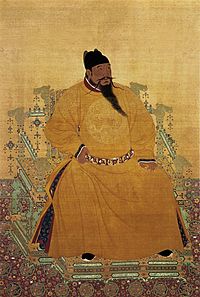Yongle Emperor
Royalty
The Yongle Emperor (2 May 1360 – 12 August 1424), formerly romanized as the Yung-lo or Yonglo Emperor, was the third emperor of the Ming Dynasty in China, reigning from 1402 to 1424.Born as Zhu Di, he was originally created Prince of Yan (燕王) in May 1370, with his capital at Beiping (modern Beijing). Amid the continuing struggle against the Mongols, Zhu Di consolidated his own power and eliminated rivals such as the successful general Lan Yu. He initially accepted his father's appointment of his elder brother Zhu Biao and then his teen-aged nephew Zhu Yunwen as crown prince, but when Zhu Yunwen ascended the throne as the Jianwen Emperor and began executing and demoting his powerful uncles, Zhu Di found pretext for rising in rebellion against him. Assisted in large part by eunuchs mistreated by the Hongwu and Jianwen Emperors, who both favored the Confucian scholar-bureaucrats, Zhu Di survived the initial attacks on his fief and drove south, sacking Nanjing in 1402 and declaring his new era the Yongle or the time of "Perpetual Happiness".Anxious to establish his own legitimacy, Zhu Di voided the entire reign of his young nephew and established a wide-ranging effort to destroy or falsify records concerning his childhood and rebellion. This included a massive purge of the Confucian scholars in Nanjing and grants of extraordinary extralegal authority to the eunuch secret police. One favorite was Zheng He, who employed his authority to launch major voyages of exploration into the South Pacific and Indian Oceans. The difficulties in Nanjing also led the Yongle Emperor to re-establish Beiping as another (and primary) capital: Beijing. He repaired and reopened the Grand Canal and, between 1406 and 1420, directed the construction of the Forbidden City. He was also responsible for the Porcelain Tower of Nanjing, considered one of the wonders of the world before its destruction by the Taiping rebels in 1856. As part of his continuing attempt to control the scholars, the Yongle Emperor also greatly expanded the imperial examination system in place of his father's use of personal recommendation and appointment. These scholars completed the monumental Yongle Encyclopedia during his reign.The Yongle Emperor died while personally campaigning against the Mongols. He is buried in the Changling Tomb, the central and largest mausoleum of the Ming Dynasty Tombs located north of Beijing.
Personal facts
| Alias (AKA) | 朱棣 Zhu Di Chu Ti 永樂帝 永乐帝 Ming Yongle Yongledi Ming Yung-lo Yung-lo-ti Yung-lo Ti Yung-lo Emperor 明成祖 Ming Chengzu Ming Ch'eng-tsu Ming Cheng-tsu Cheng Tsu 啓天弘道高明肇運聖武神功純仁至孝文皇帝 Qitian Hongdao Gaoming Zhaoyun Shengwu Shengong Chunren Zhixiao Wen Huangdi Wen Huangdi Ch'i-t'ien Hung-tao Kao-ming Chao-yün Sheng-wu Shen-kung Ch'un-jen Chih-hsiao Wen Huang-ti Wen Huang-ti |
|---|
| Birth date | May 02, 1360 |
|---|
| Birth place | |
|---|
| Date of death | August 12, 1424 |
|---|
| Place of death | |
|---|
| Resting place | |
|---|
| Parents | |
|---|
| Spouse | Empress Xu (Ming dynasty) |
|---|
